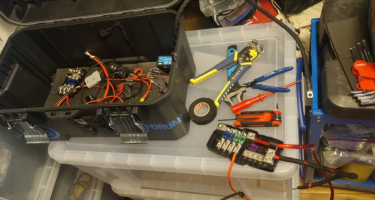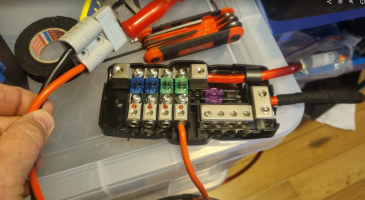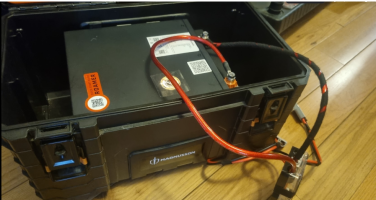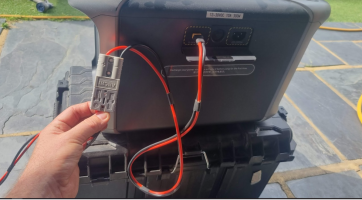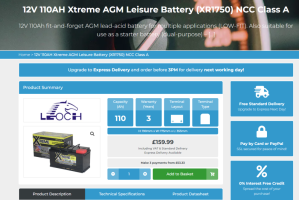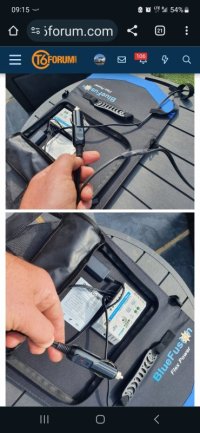Test number 3 completed today.
This was with the Bluefusion 50W panel connected directly the the CTEK250SE installed in my van, not using the controller that was supplied with the solar panels.
To start with I had to make up some cables as follows:
- I cut the cable between the solar panel and the solar controller supplied with it and inserted a pair of powerpole connectors on each of the cut ends
- I made a new extension cable from 14AWG red/black and terminated each end in a pair of powerpole connectors
- I made a short cable from 14AWG cable terminated in a pair of powerpole connectors on one end and M8 eyelets on the other. This connects to the CTEK
This enables me to connect the original controller to the panels or to disconnect the original controller and connect via the extension cable to the CTEK, thus giving me the flexibility to connect to other stuff if i need to (e.g. direct to the Starter battery or to one of my motorcycle batteries).
The cables look like this:
View attachment 71894
Connected to the original controller:
View attachment 71895
Bypassing the original controller:
View attachment 71896
And the short connector added to the CTEK: I then just poked the connector through so it is easily accessible from under the front of the drivers seat.
View attachment 71897
So with the cabling made up I started the test in the same way as the previous two.
I connected the panel a little before 7AM this morning and laid it on the roof. At this time there is no sun on the van.
BM2 reading from before connecting up:
View attachment 71898
The sun gets on to the van around 9.30AM. You will see in the trace below that there was a very small charge up until around 9.30 and from then it increased significantly and continued to climb pretty much all day. This looks much less peaky than the two previous tests. I moved the panel onto the front of the van up against the windscreen but I can’t remember exactly when. I think it was where the slight dip is at 14:30ish. It was obviously catching more light from then on as the graph gets a little steeper.
Unfortunately I had to go out in the van at 3PM hence the test ending then. I’d have like to have got to the point where the CTEK started to trickle charge the starter battery but I didn’t get that far.
View attachment 71899
At 3PM I took my dog for a walk on the beach (I live very close). While I was there I thought I’d stick the panel on again but this time inside the windscreen. Later in the day, laid flatter and behind the glass so probably not the optimal setup but worth a go and a rel life situation. This is the trace extended to include that period. The two high peaks are the drive there and the drive back, the flat section where it is around 13.5V is the period the panel was connected up in this way:
View attachment 71901
As I said, I’d like to have got to the point where the CTEK started to trickle charge the starter battery but other than that I am very pleased with the results.
I set out to test whether a cheapish portable solar panel would be capable of charging starter or leisure batteries for periods where the van is not in use or whilst remote and parked up. I’m happy that it will do this given decent sunshine. What I have learned is that the CTEK appears to be the better way of charging the leisure battery. I’d like to test the reverse charge of the starter battery but will need to find a suitable window where I can leave the van for longer to do this. A higher output panel would obviously do this more quickly but i think for my personal needs what I have works.

